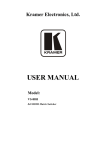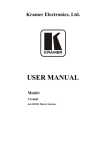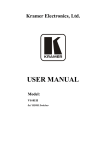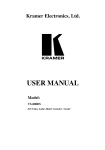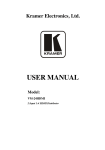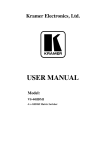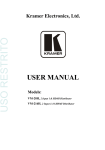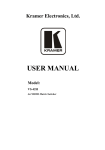Download USER MANUAL
Transcript
Kramer Electronics, Ltd. Preliminary USER MANUAL Model: VS-88H 8x8 HDMI Matrix Switcher Contents Contents 1 2 2.1 3 3.1 3.2 3.3 3.4 4 5 6 7 7.1 7.2 Introduction Getting Started Quick Start Overview Defining EDID About HDMI About HDCP Recommendations for Best Performance Your VS-88H 8x8 HDMI Matrix Switcher Installing the VS-88H on a Rack Connecting a VS-88H 8x8 HDMI Matrix Switcher Operating the VS-88H 8x8 HDMI Matrix Switcher Switching an Input to an Output Acquiring the EDID 1 1 2 3 3 4 5 5 5 8 9 10 10 10 7.3 7.4 7.5 Storing and Recalling a Setting Connecting to the VS-88H via RS-232 Controlling via ETHERNET 12 12 13 Technical Specifications Communication Parameters Kramer Protocol 2000 14 15 16 7.2.1 7.2.2 7.2.3 7.5.1 7.5.2 8 9 10 Acquire an EDID from a Connected Output Acquire an EDID from Several Sets of Inputs and Outputs Acquire the Default EDID 10 11 11 Connecting the ETHERNET Port directly to a PC (Crossover Cable) 13 Connecting the ETHERNET Port via a Network Hub (Straight-Through Cable) 14 Figures Figure 1: VS-88H 8x8 HDMI Matrix Switcher Figure 2: Connecting a VS-88H 8x8 HDMI Matrix Switcher Figure 3: Local Area Connection Properties Window Figure 4: Internet Protocol (TCP/IP) Properties Window 6 9 13 14 Tables Table 1: VS-88H 8x8 HDMI Matrix Switcher Front Panel Features Table 2: Technical Specifications of the VS-88H Table 3: Communication Parameters Table 4: Protocol Definitions Table 5: Instruction Codes for Protocol 2000 7 14 15 16 17 i Introduction 1 Introduction Welcome to Kramer Electronics! Since 1981, Kramer Electronics has been providing a world of unique, creative, and affordable solutions to the vast range of problems that confront the video, audio, presentation, and broadcasting professional on a daily basis. In recent years, we have redesigned and upgraded most of our line, making the best even better! Our 1,000-plus different models now appear in 11 groups 1 that are clearly defined by function. Congratulations on purchasing your Kramer VS-88H 8x8 HDMI Matrix Switcher. The VS-88H is ideal for conference room presentations and advertising applications, as well as for rental and staging. Each package includes the following items: • VS-88H 8x8 HDMI Matrix Switcher • Power cord • Windows®-based Kramer control software 2 • Windows®-based Ethernet Configuration Manager and Virtual Serial Port Manager • Kramer RC-IR3 Infrared Remote Control Transmitter (including the required batteries and a separate user manual3) • This user manual 3 2 Getting Started We recommend that you: • Unpack the equipment carefully and save the original box and packaging materials for possible future shipment • Review the contents of this user manual • Use Kramer high performance high resolution cables 4 1 GROUP 1: Distribution Amplifiers; GROUP 2: Switchers and Matrix Switchers; GROUP 3: Control Systems; GROUP 4: Format/Standards Converters; GROUP 5: Range Extenders and Repeaters; GROUP 6: Specialty AV Products; GROUP 7: Scan Converters and Scalers; GROUP 8: Cables and Connectors; GROUP 9: Room Connectivity; GROUP 10: Accessories and Rack Adapters; GROUP 11: Sierra Products 2 Downloadable from our Web site at http://www.kramerelectronics.com 3 Download up-to-date Kramer user manuals from our Web site at http://www.kramerelectronics.com 4 The complete list of Kramer cables is on our Web site at http://www.kramerelectronics.com 1 Getting Started 2.1 Quick Start This quick start chart summarizes the basic setup and operation steps. 2 KRAMER: SIMPLE CREATIVE TECHNOLOGY Overview 3 Overview The VS-88H is a high quality 8x8 matrix switcher for HDMI signals that fits into one vertical space of a standard 19” professional rack enclosure. In particular, the VS-88H features: • Support for up to 2.25Gbps bandwidth per graphic channel 1 • Support for HDCP (High Definition Digital Content Protection) • HDMI Support – HDMI (V.1.4 with 3D, Deep Color, x.v.Color™, Lip Sync) • 3D Pass-Through • I-EDIDPro™ Kramer Intelligent EDID Processing™, an intelligent EDID handling and processing algorithm that ensures Plug and Play operation for HDMI systems • Kramer reKlocking™ & Equalization Technology that rebuilds the digital signal to travel longer distances • A PANEL LOCK button to prevent unwanted tampering with the buttons on the front panel • 16 preset memory locations for quick access to common configurations Control the VS-88H using the front panel buttons, or remotely via: • RS-232 serial commands transmitted by a touch screen system, PC, or other serial controller • The Kramer infrared remote control transmitter • The ETHERNET 3.1 Defining EDID The Extended Display Identification Data (EDID 2) is a data-structure, provided by a display, to describe its capabilities to an HDMI source. The EDID enables the VS-88H to “know” what kind of monitor is connected to the output. The EDID includes the manufacturer’s name, the product type, the timing data supported by the display, the display size, luminance data and (for digital displays only) the pixel mapping data. See section 7.2 for details of how to acquire the EDID. 1 Suitable for resolutions up to UXGA at 60Hz, and for all HD resolutions 2 Defined by a standard published by the Video Electronics Standards Association (VESA) 3 Overview 3.2 About HDMI High-Definition Multimedia Interface (HDMI) is an uncompressed all-digital 1 audio/video interface, widely supported in the entertainment and home cinema industry. It delivers the highest high-definition image and sound quality. Note that Kramer Electronics Limited is an HDMI Adopter and an HDCP Licensee. In particular, HDMI: • Provides a simple 2 interface between any audio/video source, such as a set-top box, DVD player, or AV receiver and video monitor, such as a digital flat LCD/plasma television (DTV), over a single lengthy 3 cable • Supports standard, enhanced, high-definition video, and multichannel digital audio 4 on a single cable • Transmits all ATSC HDTV standards and supports 8-channel digital audio, with bandwidth to spare to accommodate future enhancements and requirements • Benefits consumers by providing superior, uncompressed digital video quality via a single cable 5, and user-friendly connector • Is backward-compatible with DVI (Digital Visual Interface) • Supports CEC, two-way communication between the video source (such as a DVD player) and the digital television, enabling new functionality such as automatic configuration and one-button play HDMI has the capacity to support existing high-definition video formats (720p, 1080i, and 1080p, 2K and 4K), standard definition formats such as NTSC or PAL, as well as 480p and 576. 1 Ensuring an all-digital rendering of video without the losses associated with analog interfaces and their unnecessary digitalto-analog conversions 2 With video and multi-channel audio combined into a single cable, the cost, complexity, and confusion of multiple cables currently used in AV systems is reduced 3 HDMI technology has been designed to use standard copper cable construction at up to 15m 4 HDMI supports multiple audio formats, from standard stereo to multi-channel surround-sound. HDMI has the capacity to support Dolby 5.1 audio and high-resolution audio formats 5 HDMI provides the quality and functionality of a digital interface while also supporting uncompressed video formats in a simple, cost-effective manner 4 KRAMER: SIMPLE CREATIVE TECHNOLOGY Your VS-88H 8x8 HDMI Matrix Switcher 3.3 About HDCP The High-Bandwidth Digital Content Protection (HDCP) standard (developed by Intel), protects digital video and audio signals transmitted over DVI or DVI connections between two HDCP-enabled devices to eliminate the reproduction of copyrighted material. To protect copyright holders (such as movie studios) from having their programs copied and shared, the HDCP standard provides for the secure and encrypted transmission of digital signals. 3.4 Recommendations for Best Performance To achieve the best performance: • Use only good quality connection cables 1 to avoid interference, deterioration in signal quality due to poor matching, and elevated noise levels (often associated with low quality cables). • Avoid interference from neighboring electrical appliances that may adversely influence signal quality and position your Kramer VS-88H away from moisture, excessive sunlight and dust 4 Your VS-88H 8x8 HDMI Matrix Switcher Figure 1 and Table 1 define the VS-88H. 1 Available from Kramer Electronics on our Web site at http://www.kramerelectronics.com 5 Your VS-88H 8x8 HDMI Matrix Switcher Figure 1: VS-88H 8x8 HDMI Matrix Switcher 6 KRAMER: SIMPLE CREATIVE TECHNOLOGY Your VS-88H 8x8 HDMI Matrix Switcher Table 1: VS-88H 8x8 HDMI Matrix Switcher Front Panel Features 1 # 2 3 4 5 6 7 8 9 10 11 12 13 14 15 16 17 18 Feature IR Receiver Function The yellow LED lights when receiving signals from the Infrared remote control transmitter POWER LED Illuminates when the unit is turned ON ALL Button Pressing ALL before pressing an input button, connects that input to all outputs 1 OFF Button Pressing OFF after pressing an output button disconnects that output from the inputs. To disconnect all the outputs, press the ALL button and then the OFF button SELECT IN Select the input to switch to the output (from 1 to 8) Buttons 2 OUT Select the output to which the input is switched (from 1 to 8) 3 STO Button Press to store the current settings (see section 7.3) RCL Button Press to recall the current settings3 (see section 7.3) LOCK Button Press and hold to toggle disengaging the front panel buttons and to acquire the EDID EDID Button Press EDID to capture the EDID (see section 7.2) OUTPUT/ INPUT Displays the selected input switched to the output (marked above 7-segment LCD Display each input) IN HDMI Connectors Connect to the HDMI sources (from 1 to 8) OUT HDMI Connectors Connect to the HDMI acceptors (from 1 to 8) RS-232 9-pin D-sub Port Connects to the PC or other RS-232 Remote Controller ETHERNET Connector Connects to the PC or other Ethernet Controller ETH RESET Button Press the ETHERNET factory reset button to reset to the factory default definitions 4: IP number − 192.168.1.39 Mask – 255.255.255.0 Gateway – 192.168.1.1 Power Connector with Fuse AC connector enabling power supply to the unit Power Switch Illuminated switch for turning the unit ON or OFF 1 For example, press ALL and then Input button # 2 to connect input # 2 to all the outputs 2 Are also used for storing machine setups (see section 7.3) 3 The input/output routing configuration is saved/recalled 4 First turn the VS-88H OFF and then turn it ON again while pressing the RESET button. The unit will power up and load its memory with the factory default definitions 7 Installing the VS-88H on a Rack 5 Installing the VS-88H on a Rack This section provides instructions for rack mounting the unit. 8 KRAMER: SIMPLE CREATIVE TECHNOLOGY Connecting a VS-88H 8x8 HDMI Matrix Switcher 6 Connecting a VS-88H 8x8 HDMI Matrix Switcher To connect the VS-88H 8x8 HDMI Matrix Switcher, as illustrated in the example in Figure 2, do the following 1: 1. Connect2 up to eight HDMI sources (for example, DVD players) to the eight INPUT HDMI connectors. 2. Connect3 the eight OUTPUT HDMI connectors to up to eight HDMI acceptors (for example, LCD displays with built-in speakers). 3. If required, connect a PC and/or controller to the RS-232 port (see section 7.4) and/or the ETHERNET port (see section 7.5). 4. Connect the power connector to the mains electricity (not shown in Figure 2). 5. If required, acquire the EDID (see section 7.2) Press the SELECT IN and OUT buttons to choose which HDMI input to route to a selected output. Figure 2: Connecting a VS-88H 8x8 HDMI Matrix Switcher 1 Switch OFF the power on each device before connecting it to your VS-88H. After connecting your VS-88H, switch on its power and then switch on the power on each device 2 You do not have to connect all the HDMI sources 3 You do not have to connect all the outputs 9 Operating the VS-88H 8x8 HDMI Matrix Switcher 7 Operating the VS-88H 8x8 HDMI Matrix Switcher This section describes how to: • Route an input to an output (see section 7.1) • Acquire the EDID (see section 7.2) • Store and recall a setting (see section 7.3) • Control the machine via RS-232 (see section 7.4) • Control the machine via the ETHERNET port (see section 7.5) 7.1 Switching an Input to an Output Press an output key, followed by an input key to route this input to that output. 7.2 Acquiring the EDID The EDID is a data structure transmitted by the display that enables the VS-88H to “know” what kind of monitor is connected to the output. The VS-88H acquires and stores the EDID to make reconnection to the display effortless. You can acquire the EDID: • From one output to any of the eight inputs (see section 7.2.1) • From several sets of inputs and outputs (see section 7.2.2) • From the default EDID (see section 7.2.3) 7.2.1 Acquire an EDID from a Connected Output To acquire or change the EDID of a new output display: 1. Turn the VS-88H ON. 2. Connect the required acceptor to the output from which you want to acquire the EDID. 3. Press the EDID and STO buttons simultaneously and hold them for 3 seconds. Both buttons flash. 4. Press the input button to which the EDID will be copied. The selected input number flashes on the display. 5. Select the output from which the EDID will be acquired. 6. Press the EDID button. The process is complete when the display returns to normal. 10 KRAMER: SIMPLE CREATIVE TECHNOLOGY Operating the VS-88H 8x8 HDMI Matrix Switcher 7.2.2 Acquire an EDID from Several Sets of Inputs and Outputs To acquire the EDID for more than one output (for example, OUT 1 to IN 1 and OUT 6 to IN 3), do the following: 1. Turn the VS-88H ON. 2. Connect the required acceptor to the output from which you want to acquire the EDID. 3. Press the EDID and STO buttons simultaneously and hold them for 3 seconds. Both buttons flash. 4. Press the input button to which the EDID will be copied (for example, IN 1). The selected input number flashes on the display. 5. Select the output from which the EDID will be acquired (for example, OUT 1). 6. Press the IN 1 button. The IN 1 button ceases to flash. 7. Press the next input button to which the EDID will be copied (for example, IN 3). The selected input number flashes on the display. 8. Select the output from which the EDID will be acquired (for example, OUT 6). 9. Press the IN 3 button. The IN 3 button ceases to flash. 10. Press the input buttons to which you want to copy the EDID (for example, IN 1 and IN 3). 11. Make sure that the relevant input numbers flash on the display. 12. Press the EDID button. The process is complete when the display returns to normal. 7.2.3 Acquire the Default EDID To reset to the default EDID, do the following: 1. Turn the VS-88H ON. 2. Press the EDID and STO buttons simultaneously and hold them for 3 seconds. Both buttons flash. 3. Press the input button to which the EDID will be copied. The selected input number flashes on the display. 11 Operating the VS-88H 8x8 HDMI Matrix Switcher 4. Press the OFF button until a "0" (zero) appears on the display. 5. Press the EDID button. The process is complete when the display returns to normal. 7.3 Storing and Recalling a Setting You can use the STO and RCL buttons to store up to 16 setups and then recall them. To store a setting: 1. Set the machine to the desired setting. For example, press the OUT 3 button and IN 4 button1. 2. Press the STO button. The STO button flashes. 3. Select an OUT or IN SELECT button to store the machine setting (for example, OUT 5). 4. Press the LOCK button2 to store the current setup. In this example, the OUT 5 button stores the setting. To recall a setup: 1. Press the RCL button. The RCL button flashes. 2. Press the relevant OUT or IN button that stored the setting. In this example, press OUT 5. 3. Press the LOCK button to recall the stored setting. 7.4 Connecting to the VS-88H via RS-232 You can connect to the VS-88H via an RS-232 connection using, for example, a PC. Note that a null-modem adapter/connection is not required. To connect to the VS-88H via RS-232: • Connect the RS-232 9-pin D-sub rear panel port on the VS-88H unit via a 9-wire straight cable (only pin 2 to pin 2, pin 3 to pin 3, and pin 5 to pin 5 need to be connected) to the RS-232 9-pin D-sub port on your PC 1 You can set all the switcher IN-OUT buttons 2 You have to press the LOCK button within 10 seconds, before the store operation times out 12 KRAMER: SIMPLE CREATIVE TECHNOLOGY Operating the VS-88H 8x8 HDMI Matrix Switcher 7.5 Controlling via ETHERNET You can connect the VS-88H via the Ethernet, using a crossover cable (see section 7.5.1) for direct connection to the PC or a straight through cable (see section 7.5.2) for connection via a network hub or network router 1. 7.5.1 Connecting the ETHERNET Port directly to a PC (Crossover Cable) You can connect the Ethernet port of the VS-88H to the Ethernet port on your PC, via a crossover cable with RJ-45 connectors. This type of connection is recommended for identification of the factory default IP Address of the VS-88H during the initial configuration After connecting the Ethernet port, configure your PC as follows: 1. On your desktop, right-click the My Network Places icon. 2. Select Properties. 3. Right-click Local Area Connection Properties. 4. Select Properties. The Local Area Connection Properties window appears. 5. Select the Internet Protocol (TCP/IP) and click the Properties Button (see Figure 3). Figure 3: Local Area Connection Properties Window 1 After connecting the Ethernet port, you have to install and configure your Ethernet Port. For detailed instructions, see the “Ethernet Configuration (FC-11) guide.pdf” file in the technical support section on our Web site: http://www.kramerelectronics.com 13 Technical Specifications 6. Select Use the following IP Address, and fill in the details as shown in Figure 4. 7. Click OK. Figure 4: Internet Protocol (TCP/IP) Properties Window 7.5.2 Connecting the ETHERNET Port via a Network Hub (StraightThrough Cable) You can connect the Ethernet port of the VS-88H to the Ethernet port on a network hub or network router, via a straight through cable with RJ-45 connectors. 8 Technical Specifications The VS-88H technical specifications are shown in Table 2: 1 Table 2: Technical Specifications of the VS-88H INPUTS: OUTPUTS: BANDWIDTH: COMPLIANCE WITH HDMI STANDARD: RESOLUTION: POWER SOURCE: CONTROLS: DIMENSIONS: WEIGHT: ACCESSORIES: OPTIONS: 8 HDMI Connectors 8 HDMI Connectors Supports up to 2.25Gbps bandwidth per graphic channel Supports HDMI and HDCP Up to UXGA; 1080p 100−240V AC, 50/60Hz, 33VA Front panel buttons, infrared remote control transmitter, RS-232, Ethernet 19” x 7” x 1U (W, D, H) 2.5kg (5.5lbs) approx. Power cord, IR transmitter, rack ”ears” Kramer HDMI cables 1 1 Specifications are subject to change without notice 14 KRAMER: SIMPLE CREATIVE TECHNOLOGY Communication Parameters 9 Communication Parameters Table 3: Communication Parameters RS-232 Protocol 2000 Baud Rate: 9600 Data Bits: 8 Stop Bits: 1 Parity: None Command Format: HEX Example (Output 1 to Input 1): 0x01, 0x81, 0x81, 0x81 Ethernet Default Settings Reset Ethernet Default Settings IP Address: 192.168.1.39 Power cycle the unit while holding in the Factory Reset button, located on the rear panel of the unit. TCP Port #: 5000 1 For best results, use Kramer cables such as the C-HM/HM series, the C-HM/DM series and/or our HDMI over fiber optics C-FOHM/FOHM series 15 Kramer Protocol 2000 10 Kramer Protocol 2000 The VS-88H is compatible with Kramer’s Protocol 2000 1 (version 0.50) (below). This RS-232/RS-485 communication protocol uses four bytes of information as defined below. The default data rate is 9600 baud, with no parity, 8 data bits and 1 stop bit. Table 4: Protocol Definitions MSB LSB 0 7 D 6 1 7 DESTINATION INSTRUCTION N5 5 N4 4 N3 3 I6 6 I5 5 I4 4 I3 3 1 7 O6 6 O5 5 O4 4 O3 3 1 7 OVR 6 X 5 M4 4 M3 3 1st byte 2nd byte 3rd byte 4th byte INPUT OUTPUT N2 2 N1 1 N0 0 I2 2 I1 1 I0 0 O2 2 O1 1 O0 0 MACHINE NUMBER M2 2 M1 1 M0 0 Bit 7 – Defined as 0. 1st BYTE: D – “DESTINATION”: 0 - for sending information to the switchers (from the PC); 1 - for sending to the PC (from the switcher). N5…N0 – “INSTRUCTION” The function that is to be performed by the switcher(s) is defined by the INSTRUCTION (6 bits). Similarly, if a function is performed via the machine’s keyboard, then these bits are set with the INSTRUCTION NO., which was performed. The instruction codes are defined according to the table below (INSTRUCTION NO. is the value to be set for N5…N0). 2nd BYTE: Bit 7 – Defined as 1. I6…I0 – “INPUT”. When switching (ie. instruction codes 1 and 2), the INPUT (7 bits) is set as the input number which is to be switched. Similarly, if switching is done via the machine’s front-panel, then these bits are set with the INPUT NUMBER which was switched. For other operations, these bits are defined according to the table. 3rd BYTE: Bit 7 – Defined as 1. O6…O0 – “OUTPUT”. When switching (ie. instruction codes 1 and 2), the OUTPUT (7 bits) is set as the output number which is to be switched. Similarly, if switching is done via the machine’s front-panel, then these bits are set with the OUTPUT NUMBER which was switched. For other operations, these bits are defined according to the table. 4th BYTE: Bit 7 – Defined as 1. Bit 5 – Don’t care. OVR – Machine number override. M4…M0 – MACHINE NUMBER. Used to address machines in a system via their machine numbers. When several machines are controlled from a single serial port, they are usually configured together with each machine having an individual machine number. If the OVR bit is set, then all machine numbers will accept (implement) the command, and the addressed machine will reply. For a single machine controlled via the serial port, always set M4…M0 = 1, and make sure that the machine itself is configured as MACHINE NUMBER = 1. 1 The instruction codes in Table 4 are a sub-set of the Protocol 2000. You can find the full protocol on our Web site at http://www.kramerelectronics.com 16 KRAMER: SIMPLE CREATIVE TECHNOLOGY Kramer Protocol 2000 Table 5: Instruction Codes for Protocol 2000 Note: All values in the table are decimal, unless otherwise stated. 0 1 # INSTRUCTION DESCRIPTION RESET VIDEO SWITCH VIDEO 3 STORE VIDEO STATUS 4 5 RECALL VIDEO STATUS REQUEST STATUS OF A VIDEO OUTPUT REQUEST WHETHER SETUP IS DEFINED/VALID INPUT IS DETECTED LOCK FRONT PANEL 15 30 31 DEFINITION FOR SPECIFIC INSTRUCTION INPUT OUTPUT 61 REQUEST WHETHER PANEL IS LOCKED IDENTIFY MACHINE 62 DEFINE MACHINE 0 Set equal to video input which is to be switched (0 = disconnect) Set as SETUP # Set as SETUP # Set as SETUP # SETUP # or Input # 0 - Panel unlocked 1 - Panel locked 0 1 - video machine name 2 - audio machine name 3 - video software version 4 - audio software version 5 - RS422 controller name 6 - RS422 controller version 7 - remote control name 8 - remote software version 9 - Protocol 2000 revision 1 - number of inputs 2 - number of outputs 3 - number of setups NOTE 0 Set equal to video output which is to be switched (0 = to all the outputs) 0 - to store 1 - to delete 0 Equal to output number whose status is reqd 0 - for checking if setup is defined 1 - for checking if input is valid 1 2, 15 0 2 0 16 0 - Request first 4 digits 1 - Request first suffix 2 - Request second suffix 3 - Request third suffix 10 - Request first prefix 11 - Request second prefix 12 - Request third prefix 1 - for video 2 - for audio 3 - for SDI 4 - for remote panel 5 - for RS-422 controller 2, 3, 15 2, 3, 15 4, 3 8 13 14 NOTES on the above table: NOTE 1 - When the master switcher is reset, (e.g. when it is turned on), the reset code is sent to the PC. If this code is sent to the switchers, it will reset according to the present power-down settings. NOTE 2 - These are bi-directional definitions. That is, if the switcher receives the code, it will perform the instruction; and if the instruction is performed (due to a keystroke operation on the front panel), then these codes are sent. For example, if the HEX code 01 85 88 83 was sent from the PC, then the switcher (machine 3) will switch input 5 to output 8. If the user switched input 1 to output 7 via the front panel keypad, then the switcher will send HEX codes: 41 81 87 83 to the PC. When the PC sends one of the commands in this group to the switcher, then, if the instruction is valid, the switcher replies by sending to the PC the same four bytes that it was sent (except for the first byte, where the DESTINATION bit is set high). NOTE 3 - SETUP # 0 is the present setting. SETUP # 1 and higher are the settings saved in the switcher's memory, (i.e. those used for Store and Recall). NOTE 4 - The reply to a "REQUEST" instruction is as follows: the same instruction and INPUT codes as were sent are returned, and the OUTPUT is assigned the value of the requested parameter. The replies to instructions 10 and 11 are as per the definitions in instructions 7 and 8 respectively. For example, if the present status of machine number 5 is breakaway setting, then the reply to the HEX code 0B 80 would be HEX codes 4B 80 80 85 81 85 NOTE 8 - The reply is as in TYPE 3 above, except that here the OUTPUT is assigned with the value 0 if the setup is not defined/no valid input is detected; or 1 if it is defined/valid input is detected. 17 Kramer Protocol 2000 NOTE 13 - This is a request to identify the switcher/s in the system. If the OUTPUT is set as 0, and the INPUT is set as 1, 2, 5 or 7, the machine will send its name. The reply is the decimal value of the INPUT and OUTPUT. For example, for a 2216, the reply to the request to send the audio machine name would be (HEX codes): 7D 96 90 81 (i.e. 128dec+ 22dec for 2nd byte, and 128dec+ 16dec for 3rd byte). If the request for identification is sent with the INPUT set as 3 or 4, the appropriate machine will send its software version number. Again, the reply would be the decimal value of the INPUT and OUTPUT - the INPUT representing the number in front of the decimal point, and the OUTPUT representing the number after it. For example, for version 3.5, the reply to the request to send the version number would be (HEX codes): 7D 83 85 81 (i.e. 128dec+ 3dec for 2nd byte, 128dec+ 5dec for 3rd byte). If the OUTPUT is set as 1, then the ASCII coding of the lettering following the machine’s name is sent. For example, for the VS-7588YC, the reply to the request to send the first suffix would be (HEX codes): 7D D9 C3 81 (i.e. 128dec+ ASCII for “Y”; 128dec+ ASCII for “C”). NOTE 14 - The number of inputs and outputs refers to the specific machine which is being addressed, not to the system. For example, if six 16X16 matrices are configured to make a 48X32 system (48 inputs, 32 outputs), the reply to the HEX code 3E 82 81 82 (ie. request the number of outputs) would be HEX codes 7E 82 90 82 ie. 16 outputs NOTE 15 – When the OVR bit (4th byte) is set, then the “video” commands have universal meaning. For example, instruction 1 (SWITCH VIDEO) will cause all units (including audio, data, etc.) to switch. Similarly, if a machine is in “FOLLOW” mode, it will perform any “video” instruction. NOTE 16 - The reply to the “REQUEST WHETHER PANEL IS LOCKED” is as in NOTE 4 above, except that here the OUTPUT is assigned with the value 0 if the panel is unlocked, or 1 if it is locked. 18 KRAMER: SIMPLE CREATIVE TECHNOLOGY LIMITED WARRANTY We warrant this product free from defects in material and workmanship under the following terms. HOW LONG IS THE WARRANTY Labor and parts are warranted for seven years from the date of the first customer purchase. WHO IS PROTECTED? Only the first purchase customer may enforce this warranty. WHAT IS COVERED AND WHAT IS NOT COVERED Except as below, this warranty covers all defects in material or workmanship in this product. The following are not covered by the warranty: 1. Any product which is not distributed by us or which is not purchased from an authorized Kramer dealer. If you are uncertain as to whether a dealer is authorized, please contact Kramer at one of the agents listed in the Web site www.kramerelectronics.com. 2. Any product, on which the serial number has been defaced, modified or removed, or on which the WARRANTY VOID IF TAMPERED sticker has been torn, reattached, removed or otherwise interfered with. 3. Damage, deterioration or malfunction resulting from: i) Accident, misuse, abuse, neglect, fire, water, lightning or other acts of nature ii) Product modification, or failure to follow instructions supplied with the product iii) Repair or attempted repair by anyone not authorized by Kramer iv) Any shipment of the product (claims must be presented to the carrier) v) Removal or installation of the product vi) Any other cause, which does not relate to a product defect vii) Cartons, equipment enclosures, cables or accessories used in conjunction with the product WHAT WE WILL PAY FOR AND WHAT WE WILL NOT PAY FOR We will pay labor and material expenses for covered items. We will not pay for the following: 1. Removal or installations charges. 2. Costs of initial technical adjustments (set-up), including adjustment of user controls or programming. These costs are the responsibility of the Kramer dealer from whom the product was purchased. 3. Shipping charges. HOW YOU CAN GET WARRANTY SERVICE 1. To obtain service on you product, you must take or ship it prepaid to any authorized Kramer service center. 2. Whenever warranty service is required, the original dated invoice (or a copy) must be presented as proof of warranty coverage, and should be included in any shipment of the product. Please also include in any mailing a contact name, company, address, and a description of the problem(s). 3. For the name of the nearest Kramer authorized service center, consult your authorized dealer. LIMITATION OF IMPLIED WARRANTIES All implied warranties, including warranties of merchantability and fitness for a particular purpose, are limited in duration to the length of this warranty. EXCLUSION OF DAMAGES The liability of Kramer for any effective products is limited to the repair or replacement of the product at our option. Kramer shall not be liable for: 1. Damage to other property caused by defects in this product, damages based upon inconvenience, loss of use of the product, loss of time, commercial loss; or: 2. Any other damages, whether incidental, consequential or otherwise. Some countries may not allow limitations on how long an implied warranty lasts and/or do not allow the exclusion or limitation of incidental or consequential damages, so the above limitations and exclusions may not apply to you. This warranty gives you specific legal rights, and you may also have other rights, which vary from place to place. NOTE : All products returned to Kramer for service must have prior approval. This may be obtained from your dealer. This equipment has been tested to determine compliance with the requirements of: EN-50081: EN-50082: CFR-47: "Electromagnetic compatibility (EMC); generic emission standard. Part 1: Residential, commercial and light industry" "Electromagnetic compatibility (EMC) generic immunity standard. Part 1: Residential, commercial and light industry environment". FCC* Rules and Regulations: Part 15: “Radio frequency devices Subpart B Unintentional radiators” CAUTION! Servicing the machines can only be done by an authorized Kramer technician. Any user who makes changes or modifications to the unit without the expressed approval of the manufacturer will void user authority to operate the equipment. Use the supplied DC power supply to feed power to the machine. Please use recommended interconnection cables to connect the machine to other components. * FCC and CE approved using STP cable (for twisted pair products) 19 For the latest information on our products and a list of Kramer distributors, visit our Web site: www.kramerelectronics.com, where updates to this user manual may be found. We welcome your questions, comments and feedback. Safety Warning: Disconnect the unit from the power supply before opening/servicing. Caution Kramer Electronics, Ltd. Web site: www.kramerelectronics.com E-mail: [email protected] P/N: 2900-000654 REV 4






















